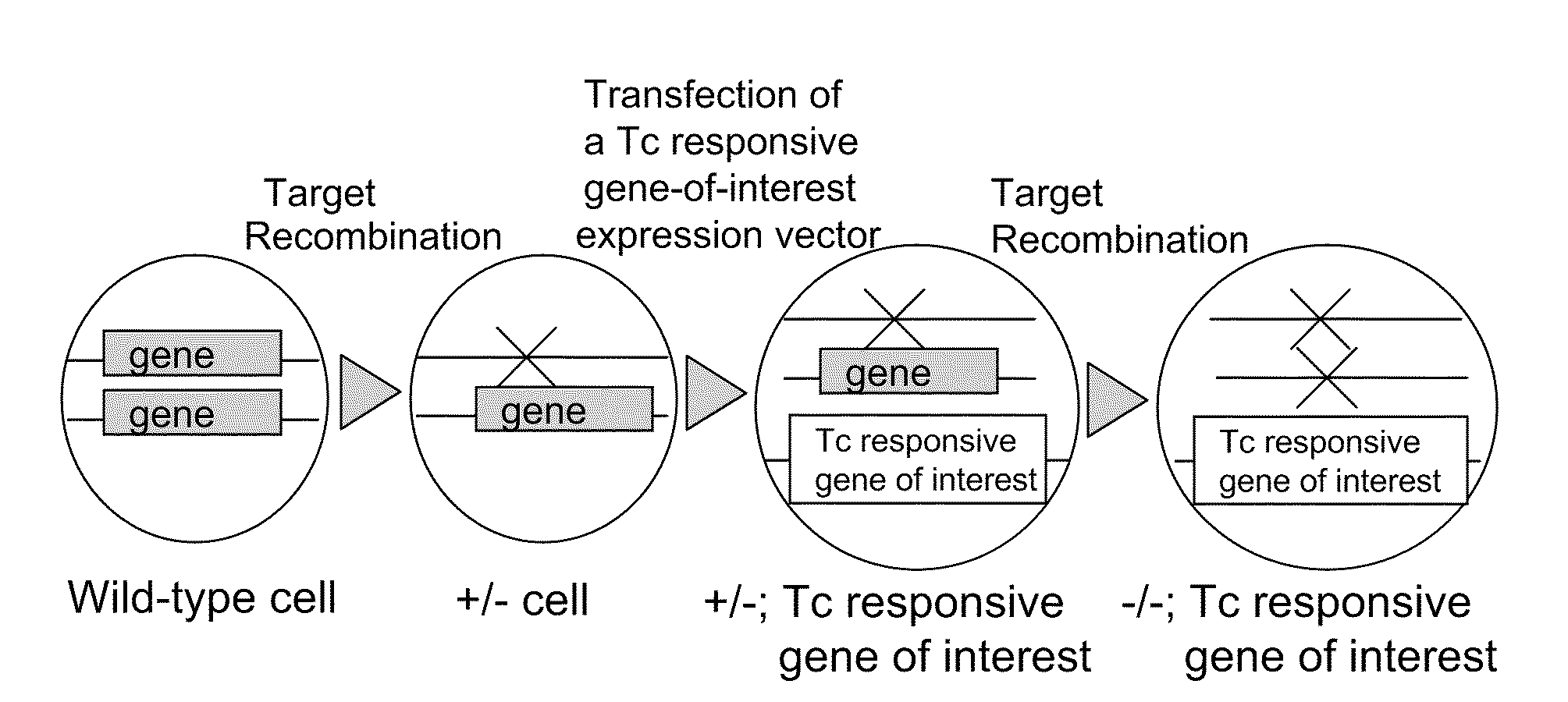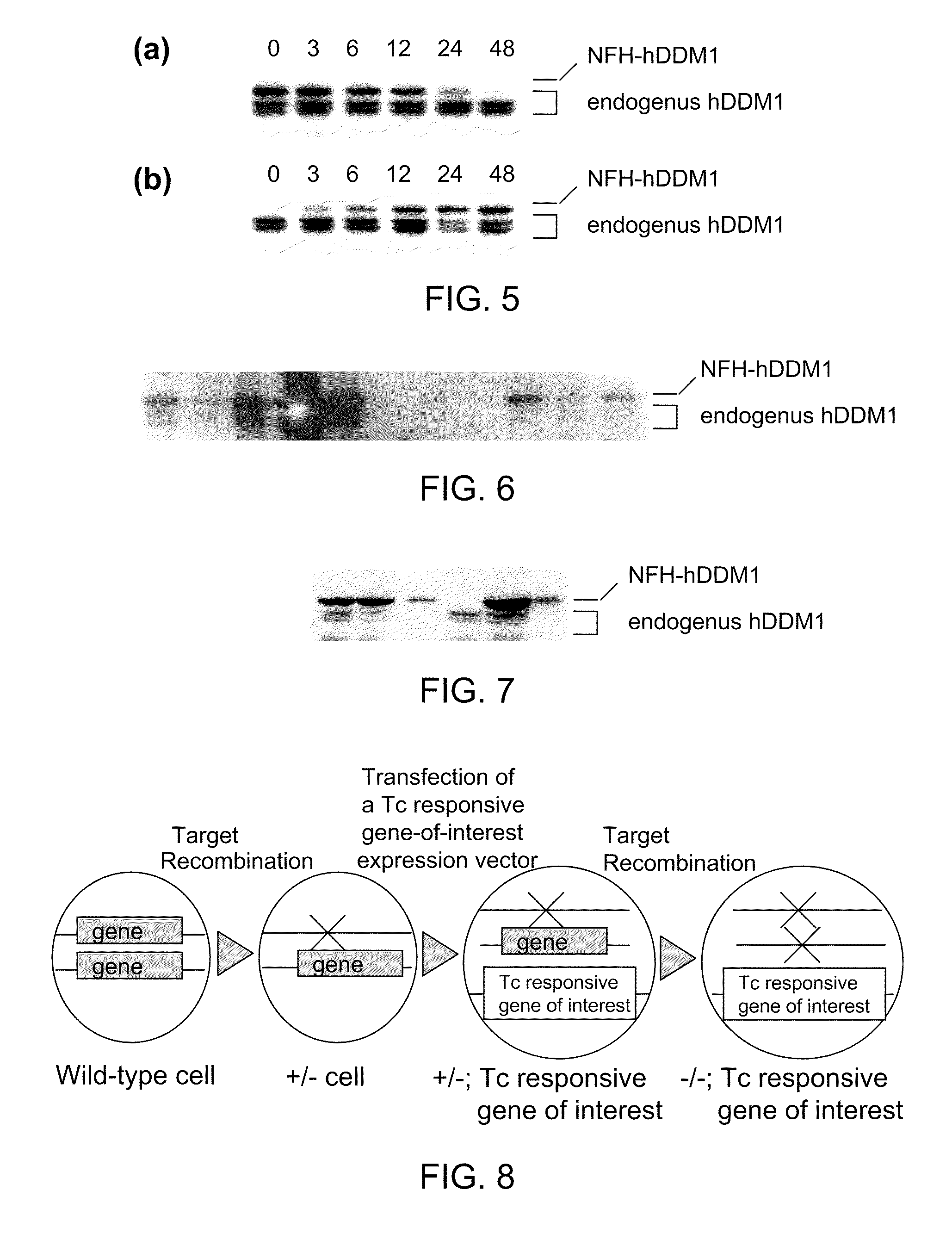Process for producing tetracycline inducible gene expressing cell line and conditional gene knockout cell line, and uses thereof
a technology of inducible gene and cell line, which is applied in the field of process for producing tetracycline, can solve the problems of not being able to select cells, not being able to control the expression of the gene of interest, and not being able to do so merely, so as to suppress the expression of the dna of interest and high the probability of cell lines
- Summary
- Abstract
- Description
- Claims
- Application Information
AI Technical Summary
Benefits of technology
Problems solved by technology
Method used
Image
Examples
first embodiment
[0084]An example in which cotransfection is performed is described as a first embodiment.
[0085]In the present invention, it is preferable that both the aforementioned vectors be cotransfected because it allows the screening steps further to be shortened and simplified. In conventional methods, as described above, it is necessary that with respect to cell lines into which TA expression vectors have been transfected, assay of luciferase expression be performed using a control vector and thereby high expression cell lines be selected. Therefore, two-stage transfection was essential for transfecting the TA expression vector and the DNA-of-interest expression vector. However, according to the present invention, since the aforementioned luciferase assay is not required, one-stage transfection (cotransfection) also is possible. Furthermore, as described earlier, candidate cell lines highly likely to be the desired cell lines can be selected by only checking the expression of the selection ...
second embodiment
[0091]Next, an example in which sequential transfection is performed is described as a second embodiment.
(A) Transfection of TA Expression Vector and DNA-of-Interest Expression Vector
[0092]The target host cell is subjected to transfection of the TA expression vector and subsequently to transfection of the DNA-of-interest expression vector. Thus, the TA expression vector and the DNA-of-interest expression vector are transfected into the genome of the host cell. The transfection method is not limited and is the same as described above (hereinafter, the same applies). In the case of the sequential transfection, in the aforementioned step (A), the order of transfection is not limited as long as after one vector is transfected, the other is transfected. For instance, after the DNA-of-interest expression vector is transfected, the TA expression vector may be transfected.
[0093]Furthermore, in the case of the sequential transfection, for example, after the TA expression vector is transfecte...
third embodiment
[0095]The present invention further may include the following step (C) as the third embodiment:
[0096](C) assaying expression of the DNA of interest in the presence and absence of the Tc compound with respect to the cell lines selected in the above-mentioned step (B).
[0097]As described above, by checking the expression of the DNA of interest in the presence / absence of the Tc compound with respect to the cell lines selected in the aforementioned step (B), it can be checked whether the cell lines are Tc inducible DNA expressing cell lines in which the expression of the DNA of interest can be regulated artificially, that is, so-called “Tc inducibility (Tc responsiveness)” can be checked. Accordingly, in the present embodiment, inducible DNA-of-interest expressing cell lines can be obtained from the candidate cell lines. Such a method makes it possible efficiently to obtain inducible DNA expressing cell lines in which the expression of the DNA of interest can be regulated artificially.
[0...
PUM
 Login to View More
Login to View More Abstract
Description
Claims
Application Information
 Login to View More
Login to View More - R&D
- Intellectual Property
- Life Sciences
- Materials
- Tech Scout
- Unparalleled Data Quality
- Higher Quality Content
- 60% Fewer Hallucinations
Browse by: Latest US Patents, China's latest patents, Technical Efficacy Thesaurus, Application Domain, Technology Topic, Popular Technical Reports.
© 2025 PatSnap. All rights reserved.Legal|Privacy policy|Modern Slavery Act Transparency Statement|Sitemap|About US| Contact US: help@patsnap.com



